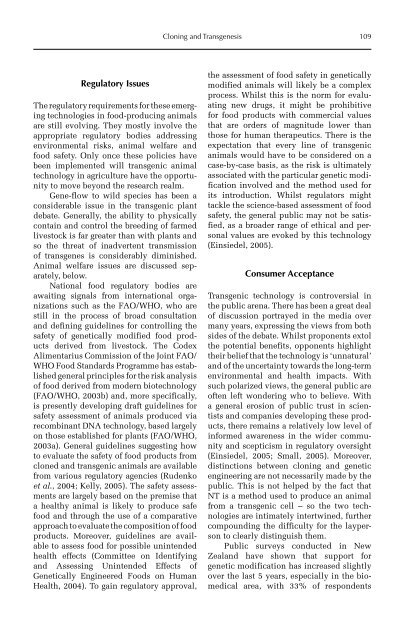Redesigning Animal Agriculture
Redesigning Animal Agriculture
Redesigning Animal Agriculture
You also want an ePaper? Increase the reach of your titles
YUMPU automatically turns print PDFs into web optimized ePapers that Google loves.
Regulatory Issues<br />
The regulatory requirements for these emerging<br />
technologies in food-producing animals<br />
are still evolving. They mostly involve the<br />
appropriate regulatory bodies addressing<br />
environmental risks, animal welfare and<br />
food safety. Only once these policies have<br />
been implemented will transgenic animal<br />
technology in agriculture have the opportunity<br />
to move beyond the research realm.<br />
Gene-flow to wild species has been a<br />
considerable issue in the transgenic plant<br />
debate. Generally, the ability to physically<br />
contain and control the breeding of farmed<br />
livestock is far greater than with plants and<br />
so the threat of inadvertent transmission<br />
of transgenes is considerably diminished.<br />
<strong>Animal</strong> welfare issues are discussed separately,<br />
below.<br />
National food regulatory bodies are<br />
awaiting signals from international organizations<br />
such as the FAO/WHO, who are<br />
still in the process of broad consultation<br />
and defining guidelines for controlling the<br />
safety of genetically modified food products<br />
derived from livestock. The Codex<br />
Alimentarius Commission of the Joint FAO/<br />
WHO Food Standards Programme has established<br />
general principles for the risk analysis<br />
of food derived from modern biotechnology<br />
(FAO/WHO, 2003b) and, more specifically,<br />
is presently developing draft guidelines for<br />
safety assessment of animals produced via<br />
recombinant DNA technology, based largely<br />
on those established for plants (FAO/WHO,<br />
2003a). General guidelines suggesting how<br />
to evaluate the safety of food products from<br />
cloned and transgenic animals are available<br />
from various regulatory agencies (Rudenko<br />
et al., 2004; Kelly, 2005). The safety assessments<br />
are largely based on the premise that<br />
a healthy animal is likely to produce safe<br />
food and through the use of a comparative<br />
approach to evaluate the composition of food<br />
products. Moreover, guidelines are available<br />
to assess food for possible unintended<br />
health effects (Committee on Identifying<br />
and Assessing Unintended Effects of<br />
Genetically Engineered Foods on Human<br />
Health, 2004). To gain regulatory approval,<br />
Cloning and Transgenesis 109<br />
the assessment of food safety in genetically<br />
modified animals will likely be a complex<br />
process. Whilst this is the norm for evaluating<br />
new drugs, it might be prohibitive<br />
for food products with commercial values<br />
that are orders of magnitude lower than<br />
those for human therapeutics. There is the<br />
expectation that every line of transgenic<br />
animals would have to be considered on a<br />
case-by-case basis, as the risk is ultimately<br />
associated with the particular genetic modification<br />
involved and the method used for<br />
its introduction. Whilst regulators might<br />
tackle the science-based assessment of food<br />
safety, the general public may not be satisfied,<br />
as a broader range of ethical and personal<br />
values are evoked by this technology<br />
(Einsiedel, 2005).<br />
Consumer Acceptance<br />
Transgenic technology is controversial in<br />
the public arena. There has been a great deal<br />
of discussion portrayed in the media over<br />
many years, expressing the views from both<br />
sides of the debate. Whilst proponents extol<br />
the potential benefits, opponents highlight<br />
their belief that the technology is ‘unnat ural’<br />
and of the uncertainty towards the long-term<br />
environmental and health impacts. With<br />
such polarized views, the general public are<br />
often left wondering who to believe. With<br />
a general erosion of public trust in scientists<br />
and companies developing these products,<br />
there remains a relatively low level of<br />
informed awareness in the wider community<br />
and scepticism in regulatory oversight<br />
(Einsiedel, 2005; Small, 2005). Moreover,<br />
distinctions between cloning and genetic<br />
engineering are not necessarily made by the<br />
public. This is not helped by the fact that<br />
NT is a method used to produce an animal<br />
from a transgenic cell – so the two technologies<br />
are intimately intertwined, further<br />
compounding the difficulty for the layperson<br />
to clearly distinguish them.<br />
Public surveys conducted in New<br />
Zealand have shown that support for<br />
genetic modification has increased slightly<br />
over the last 5 years, especially in the biomedical<br />
area, with 33% of respondents










